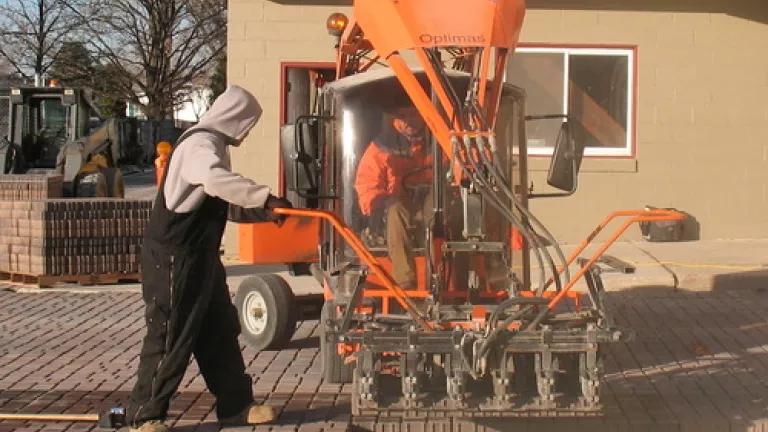
There are competing theories as to where Chicago’s “Second City” nickname originated. Some trace the moniker to a New Yorker story by A.J. Liebling; others frame the nickname in a more positive light, as a testament to the “Second City” built after the devastating fire that nearly destroyed the burgeoning metropolis in 1871.
Whatever the origin, Chicago (and its surrounding region) is quickly becoming a “Second City” when it comes to the use of innovative strategies such as green infrastructure to address stormwater runoff and sewage overflows. A draft agreement (or consent decree) between the Metropolitan Water Reclamation District (MWRD) and USEPA will do little to change that, as my colleague Ann Alexander describes (she also provides a link to the comment letter NRDC and our partners filed today). Which is really surprising, given the City of Chicago’s nationally recognized leadership on many aspects of green infrastructure (more on that below and in our report, Rooftops to Rivers II).
MWRD is the Chicago region’s wastewater utility. They have the admittedly thankless job of carrying sewage from 125 communities across Cook County to huge treatment plants…except when they don’t. Anytime we get more than 2/3 of an inch of rain – about 90 percent of the time – the system fails. Basements flood. Untreated sewage is mixed with stormwater and released in the Chicago River and, when it rains particularly hard, Lake Michigan.
That’s because Chicago, like a lot of older Midwestern and northeastern cities, has a combined sewer system. Raw sewage (think of all those flushed toilets) and stormwater runoff are combined in the same system of pipes leading to sewage treatment plants. When the treatment facility can’t handle the volume, pipes back up, forcing this toxic mix into our waterbodies.
But, in a lot of cities – like New York, Cleveland, Philadelphia and Washington, DC – USEPA or state agencies are requiring the use of green infrastructure to mitigate the problems caused by stormwater and provide an array of additional benefits. Green infrastructure is the use of natural and built systems such as wetlands, green roofs, rain gardens, bioswales, street trees and porous pavement that infiltrate or otherwise capture rain before it enters the sewer system, where it can potentially cause sewage overflows and basement flooding.
Photo courtesy of Sean Foltz, American Rivers
Just last week, New York State and New York City announced an administrative consent order that requires the city to invest more than $1 billion on green infrastructure over 20 years, as NRDC’s Executive Director, Peter Lehner, describes. The order includes the retrofit of 10 percent of the impervious area served by the city’s combined sewer system to manage the first inch of runoff onsite. Not only will this investment make New York’s waterbodies cleaner, but it will beautify communities, improve air quality, and cut energy costs.
New York’s announcement follows the execution of a landmark agreement between the Pennsylvania Department of Environmental Protection and the City of Philadelphia that commits Philadelphia to a series of performance targets that will transform at least one-third of the city’s impervious space to “greened acres” over the next 25 years, with an estimated green infrastructure investment of at least $1.67.
And, just six hours east of Chicago, the Cleveland area’s Northeast Ohio Regional Sewer District (NEORSD) will invest $42 million over eight years to implement green infrastructure projects, preventing 44 million gallons of sewage and stormwater from entering Lake Erie annually. NEORSD also the ability to propose a “gray for green” substitution, if they find that the green infrastructure elements exceed performance and cost expectations.
The GI investment in the MWRD decree pales in comparison to what other cities are required to do. There is one number that might jump out at you -- the requirement to develop retention capacity for 10,000,000 gallons of rainwater over a 15-year period. That may sound like a lot, but it’s the equivalent of retaining just 0.57 inches over one square mile of MWRD’s 883-acre service area.
What makes this all the more unfathomable is the investment many cities in MWRD’s region are already making in green infrastructure, on their own and in partnership with nonprofit and private organizations. My colleagues at the Center for Neighborhood Technology put together a spreadsheet identifying more than 160 green infrastructure projects across northeastern Illinois.
And, as I mentioned earlier, the City of Chicago has long been considered a leader in green infrastructure. It has more green roofs than any other city in North America – almost 5.5 million square feet and literally growing every day. Its Climate Action Plan contains goals to both increase that number, as well as the amount of street trees in the city, in recognition of their stormwater as well as climate adaptation benefits. And, the City’s green alley program, which replaces worn out alleys with permeable pavement, has been so successful that it’s gone from a pilot program to standard practice.

Photo courtesy of Chicago Department of Transportation
MWRD and USEPA had the opportunity to build on this work and take it to the next level, potentially transforming the region as New York, Philadelphia and Cleveland are transforming theirs. But instead, they chose the status quo.
And the status quo will forever relegate Chicago and the region to “Second City” status, per A. J. Liebling’s definition – and that’s a place no one wants to be when it comes to sewage.

